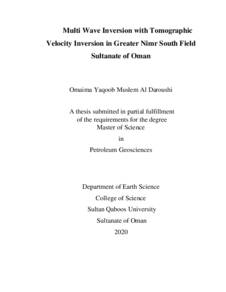Document
Multi wave inversion with tomographic velocity inversion in greater Nimr South Field Sultanate of Oman.
Identifier
Al-Daroushiyah, Omaima Yaqoob Muslem (2020). Multi wave inversion with tomographic velocity inversion in greater Nimr South Field Sultanate of Oman (Master thesis, Sultan Qaboos University, Muscat, Oman).
Publisher
Sultan Qaboos University.
Gregorian
2020
Language
English
English abstract
The accuracy of near surface velocity fields significantly affects the quality of the
land seismic data including static corrections, full-waveform inversion, and depth
imaging. P-wave refraction tomography is a robust method to characterize the near surface
but it lacks resolution in the very shallow and encounters difficulties if velocity inversions
exist. Recent advances in Surface Wave Inversion (SWI) algorithms and workflows have
demonstrated that SWI can produce high-resolution, S-wave, near-surface velocity
models. However, one limitation of SWI is that a priori information is needed to convert
the resulting S-wave velocity model into a P-wave velocity model that can be utilized in
advanced imaging workflows. This information may come from up-holes (Successive
sources at varying depths in a borehole in order to determine the velocities of the nearsurface formations) or shallow well logs but they are not always readily available.
Recently, an approach is introduced Bardainne to jointly invert P-wave first arrivals,
surface wave dispersion curves and reflectivity images to estimate a high resolution Pwave and S-wave velocity model of the near-surface. The aim of this thesis is to test this
method on an area in the south of Oman (Nimr South) with a complex near-surface,
consisting of velocity inversions and slow velocity in-filled sink holes. It is hoped that this
method will generate an accurate near-surface P-wave velocity model.
The shallow P-wave velocity model obtained from the joint inversion is used for
seismic Depth Migration Imaging in order to improve the seismic resolution in both the
shallow and deeper sections (i.e. thousands of meters). The shallow P-wave model is
merged with the tomographic velocity model obtained from non-linear slope tomography.
This merged velocity gave a robust model which has a better positioning of the low
velocity anomaly structure and captured the challenging shallow velocity inversion. The
difficult part was to get an accurate primary velocity (Vp) from Vp/Vs Ratio and capture
a deeper velocity inversions.
Member of
Resource URL
Arabic abstract
يقوم مبدأ عمل الطرق الزلزالية للمسح الجيوفيزيائي على كون الموجات المرنة تنتقل بسرعات مختلفة في الصخور المختلفة. والمبدأ هنا هو توليد هذه الموجات عند نقطة معينة ثم قياس زمن وصول الطاقة المنكسرة أو المنعكسة عن أسطح االجسام الموجودة بين التكوينات الصخرية والطبقات الرضية لعدة نقاط أخرى. باستخدام المعلومات من الموجات المنكسرة، نستطيع إيجاد تفاصيل الطبقات القريبة من سطح االرض. بالرغم من ذلك، إال أنها تفتقر الى الدقة في االماكن القريبة جدًا من السطح وتواجه صعوبات في تصوير الطبقات في حالة وجود انعكاس للسرعة )بمعنى أن تأتي سرعة أكبر تليها سرعة أقل في عمق أبعد(. حتى نستطيع حل مشكلة إنعكاس الموجة، ال بد من وجود معلومات أولية لتحويل نموذج سرعة الموجة السطحية/الثانوية )wave-S )الى سرعة الموجة الجسمية/االولية )wave-P .)قد تأتي هذه المعلومات عن طريق إحداث ثقوب سطحية فوق سطح االرض أو من سجلت الآبار السطحية ولكنها ليست متاحة دائًما بسهولة.، حديثً ُطرحت مقاربة لجمع الموجات الأولية الثانوية والصور الانعكاسية لانتاج نموذج عالي الدقة في السرعة السطحية. الهدف من هذه الاطروحة هو اختبار هذه الطريقة على منطقة في جنوب عمان )جنوب نمر( حيث يتميز ا لقياس سرعة الموجة على سطحها بانعكاسات للسرعة. نظ ًرا لهذا، من المأمول أن تتيح هذه الطريقة نموذ ًجا دقيقً السطح. في آخر خطوة يتم دمج هذي السرعة مع السرعة المحسوبة لعمق أكبر )الالف االمتار( الذي تم الحصول عليه من التصوير المقطعي لطبقات الأرض.
Category
Theses and Dissertations

